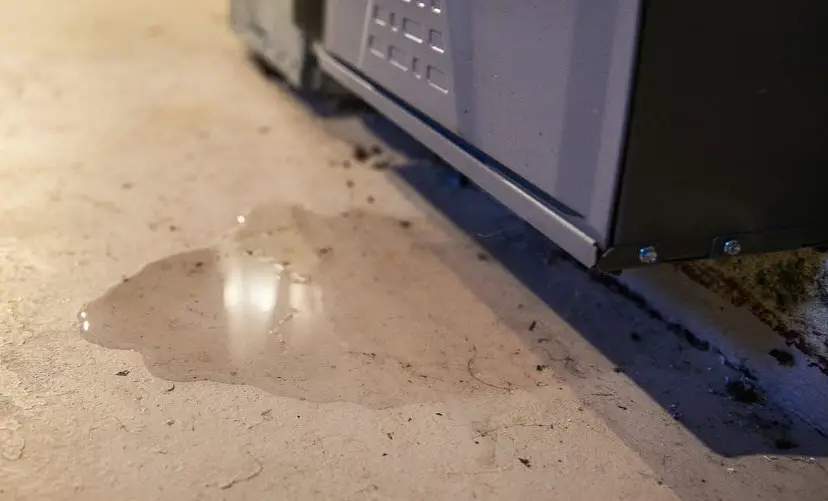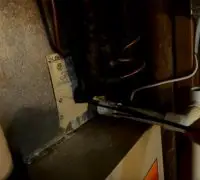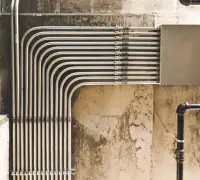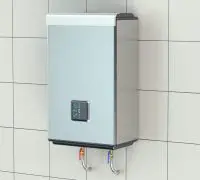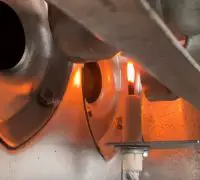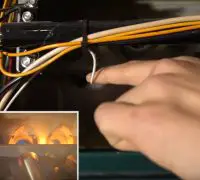It’s not fun to troubleshoot a furnace, especially when winter is right around the corner. One of the last things you want to experience is a furnace leaking water. Even if you shouldn’t make a tragedy out of it, water leaking from the furnace could signal various problems that you should address right away.
First thing first, you have to begin with knowing which type of furnace you have. Is it a high-efficiency furnace or a conventional/non-condensing model?
It’s effortless to know which type of furnace you have. You only need to take a look at the vent pipes:
- High-efficiency condensing furnaces come with white PVC white vent pipes.
- Conventional models come with metal vent pipes.
Fundamentally, you know which type of furnace you have as water leaking could mean different things for the two categories of furnaces. Keep reading for details.
Page Table of Contents
What makes the high-efficiency condensing furnace leak water?
Regardless of what you may have thought, high-efficiency furnaces will create condensation throughout the operation process. Keep in mind that they are so-called “condensing” for an excellent reason.
Water leakage from a high-efficiency furnace isn’t signaling a significant problem, and some minor repairs will solve the situation.
Here are the most common causes for condensing furnaces begin to leak:
- Condensate pump issues
Any breakage, clogging, or malfunction of the condensation pump, drain lines, or humidifier require repairs from professional HVAC professionals.
- Blocked condensate drains
Take a look at the drain trap of your furnace. If it’s dirty or clogged, you should clean it with a shop VAC.
- Problems with the condensation line
- Heat exchanger problems
Cracks in the heat exchanger, especially in the second heat exchanger, will let the water drip back into the furnace. Always contact the professionals if you suspect that it’s the heat exchangers causing the furnace to leak.
Why do high-efficiency furnaces generate water?
High-efficiency condensing furnaces come with two heat exchangers. The exchangers will collect the extra heat from the exhaust gases produced by the furnace. Throughout the extraction process, the vapors from the exhaust fumes are condensed into water. The water will be sent out through a tube, into a condensation drain, and out of your furnace.
Keep in mind that the furnace has to be correctly service to efficiently drains the water that condensates. When a clog or leak occurs, the condensation won’t be taken out of the house, causing the water to puddle around your furnace.
How can you fix it?
When your high-efficiency furnace is leaking, you can try several things to fix it. First, you should take a look at the drain trap to ensure if it’s clogged or not. Dirt and water will also build up in the drain trap, so clogging is possible. Use a shop VAC to remove the clogging.
Should the drain line, humidifier, or condensate pump be broken, you will have to call the HVAC technician for further repairs.
Why is the conventional furnace leaking water?
When the heat is on, a furnace leaking water is never a good thing, and several problems could cause water leakage. A leaky humidifier, defective vent pipe design, or some cooling and heating system issues could determine the water leakage. Scroll down for the details.
Leaky humidifier
Some furnaces come with built-in air handlers with humidifiers. The humidifiers are made to make circulating back into your home from the furnace that doesn’t get too dry. Therefore, the humidifiers utilize water to add some moisture to the air. A complicated mechanism will take the water into the humidifier that is placed outside the furnace.
Should the humidifier leak or get clogged, the water in your appliance begins to leak and ultimately drip back into your furnace.
Wrong vent pipe design
The conventional furnaces don’t collect any of the heat generated by the exhaust gases. The gases will be eliminated the moment that they’re created. Because of this situation, the cooling time for condensation to happen in the flue pipe (the vent pipe) is very short for a conventional furnace.
Condensation takes place only when the vent is wrongfully mounted or designed. If the flue pipe presents, a slope or too big/clogged, or extended are common examples. In these situations, the exhaust gas will get stuck in the pipe long enough to generate condensation so that water will leak back into the furnace.
AC issues
Sometimes, it’s not your furnace leaking water, but the Air conditioner unit. The risk for this to happen is high if the furnace is part of the HVAC system or directly/indirectly attached to the indoor AC unit.
The air conditioner has several functions, and one of them is to dehumidify the air in your house. Dehumidification means to collect water/moisture from the air. Once the steam is collected, it will drain out of the unit through the condensate drain line.
If the condensate drain line is clogged or leaky, the water will drip into appliances close to it, such as your furnace.
Is it difficult to troubleshoot the furnace problems that lead to water leakage?
If you don’t want to call the HVAC technician just yet, you may try to identify the cause for water leakage. You can begin by taking a look at the vent pipe. Observe the shape, integrity, and structure. When something feels wrong about the pipe, call the professional for further investigation. He/she may have to make several changes to the vent pipe’s installation/design, which is too complicated for most homeowners. Not only that, you don’t have the tools, but you don’t have the experience and knowledge to fix it (unless you’re an HVAC technician).
When you realize that it’s not the vent pipe causing the problem, you have to look at the built-in humidifier. Most of the time, you will be able to observe it as it’s on the exterior of your furnace. Look carefully at the humidifier and see any blockages or leaks along the humidifier’s water feed tube, the external casing, or the water drain line. Should you observe anything wrong, it’s best to call the professional to address the humidifier problems.
Water Dripping from Furnace Vent Pipe: What’s Wrong?
Once again, we should highlight that condensation is perfectly normal for condensing models (high-efficiency furnaces, with AFUE rating over 905). The condensation’s ultimate result is water, so you shouldn’t sound the alarm if you notice water around the condensing furnace. Some minor repairs will fix the water leakage.
The PVC exhaust pipe and combustion air pipe require proper installation; otherwise, they will make the water get into the furnace and even the furnace offline. Not following the manufacturer’s instructions by the contractor upon installation could cause water to drip from the vent pipe.
For example, when the PVC exhaust pipe comes with a horizontally mounted section, it should be graded ¼” per foot back to the unit, collecting in the tubes and trap, and then transmitted outside the furnace. Modern models come with various instructions, so make sure you hire an experienced contractor to install the furnace.
